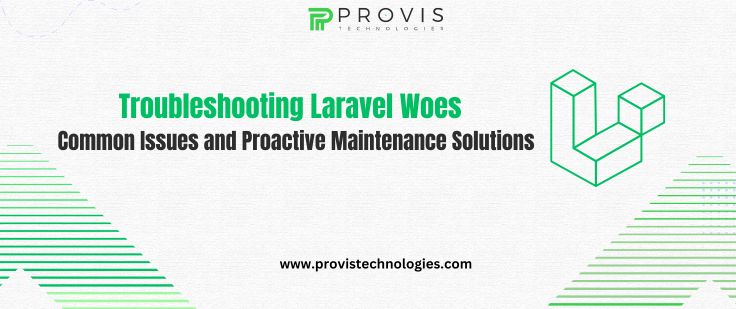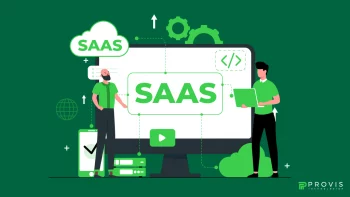Laravel, a popular PHP web application framework, has gained popularity for its elegant syntax, robust features, and developer-friendly environment. However, like any technology, it’s not immune to challenges and issues. Today, we will explore common Laravel woes and provide proactive maintenance solutions to keep your Laravel application running smoothly.
Dependency Management
Laravel utilizes Composer for dependency management, and issues often arise when packages become outdated or incompatible. To avoid this, regularly update your dependencies using composer update. Additionally, always check for Laravel updates and apply them to benefit from bug fixes and security patches.
Database Woes
Database-related problems can hinder the performance of Laravel applications. Optimize database queries, use Laravel’s Eloquent ORM efficiently, and consider indexing to enhance retrieval speeds. Regularly check for slow queries using tools like Laravel Debugbar or Telescope to identify and address performance bottlenecks.
Caching Challenges
Laravel uses various caching mechanisms to improve application speed. However, stale or corrupted cache can lead to unexpected behavior. Implement a caching strategy that suits your application’s needs, and regularly clear and refresh the cache to prevent issues.
Environment Configuration
Laravel applications often have different environments (e.g., local, development, production) – each requiring specific configurations. Misconfigurations can lead to unforeseen issues. Regularly review your environment files (env files) and ensure that configurations match the requirements of each environment.
Don’t Miss:- All You Need to Know About Website Downtime & Ways to Prevent It
Authentication & Authorization Pitfalls
Laravel’s built-in authentication & authorization mechanisms are powerful, but misconfigurations can lead to security vulnerabilities. Regularly audit your authentication and authorization logic, use Laravel’s policies and gates appropriately, and stay informed about security best practices.
Error Handling & Logging
Inadequate error handling can make debugging a nightmare. Implement robust error handling mechanisms, utilize Laravel’s logging capabilities, and regularly review error logs. Tools like Sentry or Bugsnag can help you catch and address errors before they impact users.
Task Scheduling & Queue Management
Laravel’s task scheduler & queues are essential for handling background tasks efficiently. Ensure that your tasks are scheduled appropriately and that queues are processed promptly. Regularly monitor & optimize your task scheduling & queue management to prevent delays.
Filesystem Issues
Laravel applications often deal with file uploads, storage, and retrieval. Ensure that your filesystem configurations are accurate, and regularly clean up unnecessary files to prevent storage issues. Consider cloud-based storage solutions for scalability & reliability.
Performance Bottlenecks
Performance issues can arise due to inefficient code, poorly optimized queries, or inadequate server resources. Regularly profile your application using tools like Laravel Debugbar or Blackfire.io to identify & address performance bottlenecks. Optimize code, database queries, and server configurations for improved responsiveness.
Must Know:- How to Improve User Experience on Your Website?
Security Concerns
Security is the most essential aspect. Laravel provides features like CSRF protection, encryption, and more. Stay informed about security best practices, apply Laravel updates promptly, and regularly audit your codebase for potential vulnerabilities. Utilize security tools like Laravel Fortify or integrate third-party solutions for additional layers of protection.
Conclusion
Maintaining a Laravel application involves a combination of proactive measures and swift issue resolution. Regularly updating dependencies, optimizing database queries, implementing robust error handling, and staying vigilant about security are primary aspects of keeping your application in top shape. By addressing common woes and adopting proactive maintenance solutions, you can ensure a reliable, secure, and performant web application that meets the demands of both developers & users.
Written By
Author's Picks
- Provis Technologies Is All Set to Thrive by Creating Solutions for With a 360-Degree Marketing Approach: GoodFirms
- 04/11/2022
- Importance of Progressive Web Apps (PWAs) in E-commerce
- 15/03/2024
- The Future of AI in Businesses Opportunities & Risks
- 27/10/2023
Categories
- AI for Startups
- AI in Web Development
- AI Integration
- AI Platforms
- AI Prompt
- AI Tools
- AI Trading Software
- Android App
- Android vs iOS Development
- Angular
- API
- API Development
- App
- app development
- App Idea
- App User Feedback
- Application
- Artificial Intelligence
- Audit Services
- Automotive Industry
- Awards and Recognition
- Business Consulting
- Business Website
- Chatbots
- CRM
- CRM for Financial Advisors
- Custom CRM
- Custom SaaS
- Custom Website
- Customer Service
- dashboard design
- Developing a Mobile App
- Digital Business
- E-commerce
- EMR Integration
- Finance
- Financial Advisors
- Financial Advisors
- GIT
- Health Insurance
- iOS App
- iOS App Development
- IoT Mobile App Development
- IoT Platforms
- IT Audit Services
- IT Consulting
- IT Strategies
- Java Development
- Laravel
- Lean Canvas
- Learning Management System
- Logistics Apps
- Mobile App Development
- MVP
- Native App
- News Aggregator Site
- OTT
- Outsourcing IT
- Payment Gateway
- predictive analysis
- Product Launch Strategy
- Progressive Web App (PWA)
- Prototype
- Recommender Systems
- Ruby
- SaaS
- SaaS Application
- SaaS Business
- SaaS Company
- SaaS Development
- SaaS Product
- SaaS Project
- Sales Funnel
- SEO
- Shopping Cart
- Software Development
- SSL and TLS
- Startup Checklist
- Technology
- Tetradic Color Scheme
- UI/UX Design Company
- Unit Testing
- User Flow
- User Testing
- Web Development
- Web Performance Optimization
- website Maintenance Services
- Website Migration Service
- Website Speed Optimization
- WooCommerce
- WordPress





